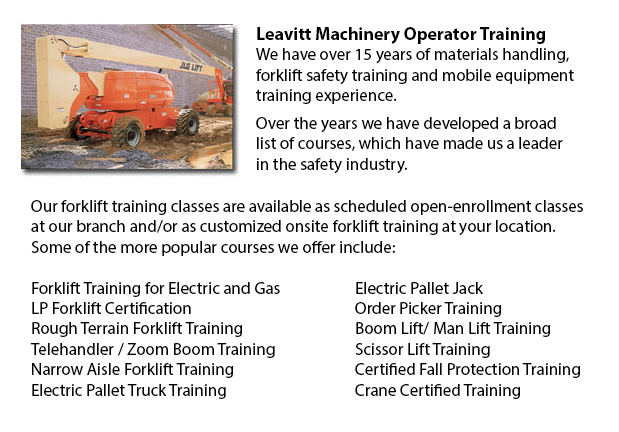
Aerial Lift Safety Training Penticton - There are roughly 26 to 30 construction deaths in North America attributed to the use of aerial lifts. Most of those killed are craftsmen such as electrical workers, laborers, painters, carpenters or ironworkers. Nearly all deaths are caused by tip-overs, electrocutions and falls. The greatest danger is from boom-supported lifts, like bucket trucks and cherry pickers. Most fatalities are connected to this particular kind of lift, with the rest involving scissor lifts. Other dangers include being struck by falling objects, being thrown out of a bucket, and being caught between the guardrail or lift bucket and an object, like for example a steel beam or joist.
The safe operation of an aerial lift requires a check on the following items prior to utilizing the device: operating and emergency controls, personal fall protection gear, safety devices, and wheels and tires. Look for possible leaks in the air, hydraulic fluid and fuel-system. Check the device for missing or loose parts.
The area where the device would be utilized must be carefully inspected for possible dangers, like for instance holes, bumps, drop-offs and debris. Overhead power lines should be closely monitored or avoided. It is recommended that aerial lift devices be utilized on surfaces that are level and stable. Don't work on steep slopes that go beyond slope limitations which the manufacturer specified. Even on a slope which is level, brakes, wheel chocks and outriggers should be set.
Companies must provide their aerial lift operators with the correct guidebooks. Mechanics and operators have to be trained by a certified individual experienced with the applicable type of aerial lift.
Aerial Lift Safety Tips:
o Close lift platform chains or doors prior to operating.
o Leaning over and climbing on guardrails is prohibited. Stand on the platform or floor of the bucket.
o Stay within manufacturer's load-capacity restrictions.
o When working near traffic, use right work-zone warnings, like signs and cones.
If right procedures are followed, electrocutions are preventable. Stay at least ten feet away from whatever power lines and qualified electricians should de-energize and/or insulate power lines. Workers need to make use of personal protective equipment and tools, like for example a bucket which is insulated. Then again, an insulated bucket does not protect from electrocution if, for instance, the person working touches another wire providing a path to the ground.
Falls are avoidable if the worker remains secure within guardrails or within the bucket by using a full-body harness or a positioning device. If there is an anchorage within the bucket, a positioning belt along with a short lanyard is acceptable.
By following the manufacturer's directions, tip-overs can be avoided. Never drive the lift platform while it is elevated, unless otherwise specified by the manufacturer. Follow the device's horizontal and vertical reach limitations, and never exceed the load-capacity which is specified.
-
Forklift Certification Schools Penticton
Forklift Certification Schools Penticton - In North America, forklift certification is mandatory, making forklift training programs essential for both the business and their employees working as operators of forklifts. Forklift training focuses on sa... More -
Telehandler Training Courses Penticton
Telehandler Training Courses Penticton - The employer has the responsibility to make sure that their personnel are trained to work proficiently utilizing telehandler machinery. The workers have to be assessed for their ability to utilize the machine.... More -
Certified Fall Protection Training in Penticton
There are many injuries at work linked to falling and lots of fall-related deaths reported each and every year. Most of these instances might have been prevented with better training, better precautions in place, and by properly equipping employees b... More -
Zoom Boom Training Penticton
Zoom Boom Training Penticton - Zoom Boom Training is designed to train operators on variable reach forklifts. The objectives of the training are to impart an understanding of the physics of the machine, and to outline the operator's job. This course... More -
Crane Training Schools Penticton
Crane Training Schools Penticton - We have designed various Mobile Crane Operation programs at our Crane Training Schools. These programs are recommended for the experienced operator who needs re-certification or certification, and for inexperienced... More -
Aerial Lift, Boom Lift, Man Lift, Scissor Lift Training in Penticton
Lift tables or also referred to as scissor hoists can lift up both individuals and materials vertically. They are normally utilized in industrial, construction and commercial environments. Normally, the use of a scissor forklift is to lift and lower... More -
Forklift Training Program Penticton
Forklift Training Program Penticton - The forklift is a common powered industrial vehicle which is in wide use nowadays. They are occasionally known as hi los, lift trucks or jitneys. A departments store will utilize the forklift to unload and load m... More -
Overhead Crane Training Penticton
Overhead Crane Training Penticton - An overhead crane is a large crane used to move and lift huge, heavy objects that cannot be lifted by hand. An overhead crane is normally fixed in position while in use. These machines are capable of moving huge vo... More

Forklift Training Penticton
TOLL FREE: 1-888-254-6157
Penticton, British Columbia
forklifttrainingpenticton.com
Email Us
About Us


